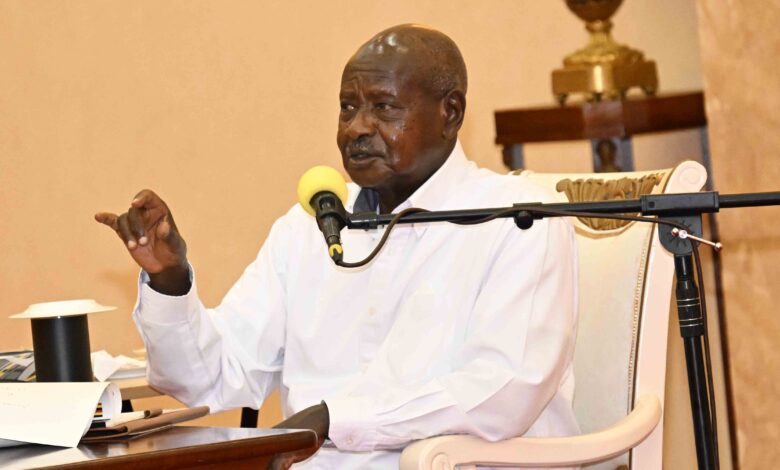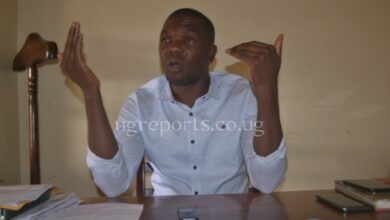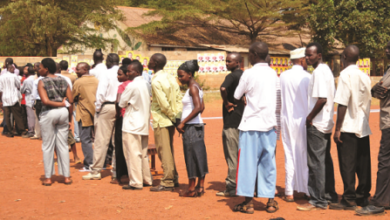President Museveni’s full speech on 38th NRM victory anniversary
The NRM’s victory on January 26, 1986, was an indicator of the resilience of our people and their ability to overcome various challenges.

By Our Reporter
Kampala: Fellow Ugandans, I greet you and congratulate you for reaching the 38th anniversary of the NRM’s victory, which will be celebrated tomorrow in Jinja.
Once again, I express my deepest condolences to the Ogwal family and the entire nation upon the loss of my sister and patriotic leader, the Honourable Cecilia Ogwal. Her love for Uganda transcended partisan politics. She worked with the party in power, the NRM, to extend services to her people. I salute her contribution to the unity and development of Uganda.
I want to use this occasion to congratulate the people of Uganda for successfully hosting the 19th Non-Aligned Movement (NAM) Summit and the Third South Summit of the G77 and China. Uganda was honored with the rare opportunity of assuming the chairmanship of both bodies. I congratulate all the government officials, the security, and the people of Uganda for working towards the success of these summits.
The NRM’s victory on January 26, 1986, was an indicator of the resilience of our people and their ability to overcome various challenges.
Fellow countrymen, countrywomen, and Bazukulu, in recent years, our country has emerged strong in the face of several challenges.
The COVID-19 pandemic that decimated lives and economic activities around the world is now behind us, although we continue to suffer from some mild effects of the pandemic.
We supported our people in many ways, including providing medicines in hospitals to treat those who were sick, vaccinating the population, providing food relief to those who were most affected, providing financial support to private sector businesses to keep them open, and continuing to employ Ugandans through UDB, Emyooga, the Small Business Recovery Fund, the Uganda Development Corporation (UDC), and the Presidential Initiative to support business hubs to improve skills and provide capital to expand their businesses.
Despite a few incidences where some ADF terrorists penetrated our borders from DR Congo and killed our tourists, Uganda is a safe and peaceful country. The security of the country remains strong, and the government is modernizing its security capabilities and infrastructure to detect terrorist incidences before they happen.
We have greatly improved our intelligence and surveillance capabilities to ensure that Ugandans and our visitors who come here are safe. The ADF terrorists who killed two tourists from the UK and South Africa plus their Ugandan tour guide were killed, but three of these are unaccounted for. Njovu, their commander, was captured, and five others, including Kamusu, the No. 2 to Njovu, were killed. That group was made up of 10 people.
Expansion in Economic Activities
On the economy, despite the effects of climate change on agriculture and our infrastructure from the floods, the conflict in Eastern Europe, which led to a rise in the prices of some strategic commodities such as oil, and the recent rise in interest rates globally, which made access to capital very expensive, the economy has continued to expand.
The economy grew to US$ 184.89 trillion (US$ 49.5 billion) in the financial year 2022-2023, up from Shs 162,750 billion (US$ 45.6 billion) registered in the financial year 2021/22. In PPP terms, the size of the economy is US$114 billion and the per capita is US$2,281. In real terms, the economy grew by 5.2 percent in the financial year 2022-2023, better than the 4.6 percent registered in the financial year 2021/22. This expansion was a result of the good performance of most sectors of the economy, with services growing at 6.2 percent (especially in trade, tourism, education, ICT, arts, and entertainment); agriculture at 4.8 percent, with food crops growing at 4.7 percent from 3.5 percent; livestock at 8.8 percent from 8.3 percent; and fish activities at 8.6 percent from 0.3 percent in FY2022/23 and FY2021/22, respectively. The growth in industry was 3.5 percent, slower than the 5.1 percent recorded in the same period the previous year.
Uganda’s economic outlook is very optimistic. This is mainly because of the consistent support for the private sector through supportive policies that create a business-friendly environment, infrastructure investments in energy, transport, and ICT, enhanced access to credit (through the Parish Development Model, Small Business Recovery Fund, Emyooga, Agriculture Credit Facility, UDB, UDC, etc.), as well as the swift and comprehensive response to the impact of the previous health crises and the regional geopolitical security issues.
The size of the economy will grow from UShs. 184.3 trillion in financial year 2022/23 to UShs. 204.9 trillion (USD 55 billion) by the end of financial year 2023/24 and then leap to UShs. 225.5 trillion in financial year 2024/25 (equivalent to USD 60 billion).
This growth will be driven by higher output in the services, industry, and agriculture sectors of the economy; a recovery in aggregate demand as inflation slows down; the continued implementation of the parish development model; expediting investments in the oil and gas sector; a continued recovery in tourism; and growth in regional trade, including in the EAC, COMESA, and globally.
Other growth initiatives will include: the government’s consistent investments in the establishment and operationalization of industrial parks; infrastructure development, including the expansion and maintenance of roads, bridges, and railways; investment in research and innovation; and affordable electricity.
The implementation of interventions to accelerate economic growth through productivity improvements and value addition to our abundant raw materials in the anchor sectors of agro-industrialization, oil and gas, mineral development, tourism, and knowledge economy development will shift the economic growth path to a level of 8 percent per annum on average over the medium term. This will increase the pace of our socio-economic transformation and build an independent, integrated, and self-sustaining economy, as was enunciated in point no. 5 of the 10 Point NRM Programmes.
Changes in the prices of goods and services (inflation)
The general increase in the prices of goods and services in the country, called inflation, slowed down from a peak of 10.7 percent in October 2022 to 2.6 percent in November 2023. This is expected to remain within the policy target of 5% over the medium term, supported by increased agricultural production, the increase in the supply of locally manufactured goods, increased exports, which increase the supply of foreign currency in the economy, increased efficiency in economic activities due to the increasing integration of new technologies, including ICT capabilities, in our manufacturing and other businesses, and good economic policies.
External Trade
Merchandise exports increased significantly, growing by 54.9 percent from USD 4,194 million in the twelve months to October 2022 to USD 6,497.9 million in the twelve months to October 2023, largely driven by gold, coffee, and maize exports. Imports grew by 26.2 percent, much slower than the growth in exports, resulting in the narrowing of the trade deficit by 11.2 percent in the same period. This is the main reason why the Ugandan shilling has remained stable, together with the strong foreign direct investment inflows and remittances of Ugandans working outside the country. This shows that the Ugandan economy remains attractive to investment, and it remains a profitable investment location.
Imports increased to USD 9,356.23 million in the 12 months to October 2023, compared to USD 7,412.71 million in the same period a year ago. The increase in imports is largely in the oil and gas sector, mineral exploration and development, vehicles, and accessories.
Export receipts are expected to increase even further as Uganda accelerates the production of light manufactured goods and middle-high-tech industrial products through value-added processes, especially with the abundant mineral reserves that the country has.
To accelerate the process of value addition, the government is reducing further the cost of electricity for manufacturers, improving transport infrastructure, including roads and railways, eliminating bureaucracy in government, especially in procurement, in order to attract new investments and technology transfer, making available affordable capital, and intensifying the fight against corruption through accelerating automation of government processes, frequent audits of government interventions, and rationalizing government institutions and departments.
Trade Flows Within the EAC Region and the Rest of the World
The EAC, as a single trade bloc, remained the major destination of Uganda’s exports in the 12 months to October 2023, accounting for 43.5 percent of total exports, followed by the Middle East (18.1 percent) and Asia (17.6 percent).
Within the EAC region, the top three destinations for Uganda’s exports in the same period were Kenya (31.5 percent), the Democratic Republic of the Congo (24.6 percent), and South Sudan (23.3 percent).
In the 12 months to October 2023, Uganda traded a surplus worth USD 716 million with EAC Partner States. However, the trade balance with Kenya and Tanzania was a deficit, meaning Uganda imported more in terms of value from those countries than exported to them. In the 12 months to October 2023, Uganda exported goods worth US$ 890 million to Kenya, US$ 696 million to the DR Congo, US$ 659 million to South Sudan, US$ 298 million to Rwanda, US$ 213 million to Tanzania, and US$ 72 million to Burundi. In total, our exports to the EAC were worth US$ 2,828 million out of a total export of US$ 6,498 million to all our trading partners.
However, this is a very tiny fraction of our exports compared to the total global exports (less than 0.003 percent). So, to accelerate our prosperity, we must significantly increase the volume and value of our exports to the global market. Through increased trade, our goal of transitioning from poverty to prosperity will be achieved much faster.
In the same period, Uganda recorded trade surpluses with the European Union and COMESA of USD 113.36 million and USD 967.34 million, respectively. Our exports to COMESA were worth US$ 2318 million, Middle East US$ 1174 million, Asia US$ 1144 million, and European Union US$ 860 million. Trade deficits were recorded with Asia and the Middle East of 2,786.57 million and 440.1 million, respectively, during the same period.
The government will soon finalize the strategy to expand Uganda’s GDP ten times from the current $50 billion (FY 2023/24) to US$ 500 billion within a decade, starting FY 2024/2025, driven by value addition and access to export markets. Countries that have exponentially grown their GDP to around US$500 billion from a base like Uganda’s (FY2022/23),have demonstrated that the primary drivers of accelerated growth were: (i) access to global markets with higher rates of growth of manufactured exports and their share of world exports of manufactured goods leaping from 9 percent in 1965 to 21 percent in 1990; (ii) increased productivity across strategic sectors; (iii) specialization through skilled human capital that supported research and development which helped to achieve competitive advantages; (iv) prudent economic policies that harnessed the comparative advantages; and peace and security that supported political stability, among others. These countries are:
- South Korea: 46 years of growth at an average annual growth rate of 13% (from US$38.0 billion in 1977 to US$1,665 billion in 2023);
- Thailand: 38 years of growth at an average annual GDP growth rate of 7.6% (from US$ 38.9 billion in 1985 to US$ 500 billion in 2023)
- Malaysia: 34 years of growth at an average annual growth rate of 8% (from US$ 38.0 billion in 1989 to US$406 billion in 2023);
- Singapore: 33 years of growth at an average growth rate per annum of 8.7% (from US $36.1bn in 1990 to US$466.8 in 2023); and
- Chile: 33 years of growth at an average annual growth rate of 4.5% (from US$33 billion in 1990 to US$316.7 billion in 2023).
Regional Integration and Development
To expand regional trade and support regional development, Uganda is undertaking joint projects with DR Congo and implementing interventions to reduce transportation costs and improve the border infrastructure to facilitate trade and financial services across the region. We are undertaking joint projects in the road sector and electricity in Eastern DR Congo. Securing this market is good for Ugandans in terms of exports and jobs.
The Ugandan government and President Tshisekedi of the Democratic Republic of the Congo will continue to work together to improve the security situation in Eastern Congo. Uganda has gained competitiveness in recent years in a number of tradeable goods, including animal products such as beef and milk, agricultural products, especially coffee, tea, fish, sugar, fresh and processed food, and industrial products such as cement, iron, and steel products, light manufactured goods, etc. However, we continue to face non-tariff barriers to our exports, which are being resolved through our discussions with the leaders of the EAC and COMESA.
Increasing tourism revenue
Tourism inflows remained resilient, recording an increase of 9 percent from USD 978.35 million in financial year 2021/22 to USD 1,066.41 million in financial year 2022/23. This growth is partly attributed to the increased confidence of travelers as the world recovers from the COVID-19 global shock, the good natural attractions that Uganda has, and peace and security. Although this is a remarkable performance, the government is putting in place interventions to increase tourism receipts to US$5 billion per year by 2028.
The global tourism and travel industry is valued at US$9.5 trillion. In 2019, foreign visitors to Uganda spent over Shs 4.6 trillion on tourism services, while domestic tourists spent about Shs 3.0 trillion, according to the Uganda Bureau of Statistics (UBOS).
In total, this is equivalent to about US$2.0 billion, which is equivalent to 0.02 percent of the global industry value. The number of tourists globally was about 965 million in 2021, compared to 1.5 million foreign tourists in Uganda (2019).
If we increase our share of tourism receipts in this global trade by 5 times to 0.1% and increase the annual number of foreign tourists by 5 times under the current average spend-per-tourist of Shs3.0 million and average length-of-stay of 8.3 nights, Uganda can potentially earn Shs23.0 trillion per year (or U$6.2 billion per year).
The lies of the European and American politicians about security and stereotypes about Uganda must, therefore, be aggressively encountered by providing the correct information through our friends in those countries and the internet to show the correct image of the country. Some of these Europeans are simply afraid of the potential that we have in our strategic areas and, therefore, want to undermine our unstoppable socio-economic transformation and that of Africa as a whole.
Other measures to boost our tourism receipts include the activation of passage and cargo services at Kabalega International Airport (KIP) in Hoima; improvements in hotel capacity and sanitation; competitive pricing; professionalization and diversification of meetings, incentives, conferences, and events (MICE); a rapid increase in the number of multilingual tour guides, including Swahili and Chinese; and expanded use of destination marketing agents.
Remittances
Remittances of Ugandans working outside the country increased to USD 1,431.23 million in FY 2022/23, higher than the value of USD 1,133.94 million registered in FY 2021/22.
Inflows of Foreign Direct Investment
Uganda continued to register growth in foreign direct investment (FDI) inflows. FDI inflows increased by 68.3 percent in FY 2022/23, largely hinged on developments in the oil sector as Uganda prepares for its first oil. FDI inflows rose from USD 1,688.56 million in FY 2021/22 to USD 2,842.65 million in FY 2022/23.
Jobs creation
Formal employment has recovered from the adverse effects of the COVID-19 pandemic. The Pay-as-You-Earn (PAYE) register expanded by 14.1 percent from 1,422,857 employees in FY2021/22 to 1,624,072 in FY2022/23, as follows:
- Uganda Development Bank (UDB) loans to projects: 41,338 jobs, up from 24,013 jobs created in 2020, of which 62 percent were held by youth.
- Free Zones Authority: 9,421 jobs, up from 8,958 in the financial year 2020/21.
- PDM: 1,627,307 members from the 148,320 enterprise groups have so far benefited from the national roll-out of the PDM.
- Emyooga: 378,640 jobs were created by December 2022, rising from 338,824 in March 2022.Kigezi, Acholi, and Lango sub-regions registered the highest number of jobs created, while Central Buganda Zone recorded the lowest number of direct jobs created.
Furthermore, the number of working Ugandans subscribing to at least one pension scheme increased by 2.24 percent (from 2,949,715 in 2020/21 to 3,015,807 in 2021/22).
Implementation of the Parish Development Model (PDM)
The PDM is the NRM Government initiative to spur growth from the bottom up and transform the population currently in subsistence to the money economy. The PDM is a pillar of point No. 5 of the NRM’s 10-Point Program to build an independent, integrated, and self-sustaining economy. To date, the government has invested Shs 2.32 trillion in the financial inclusion pillar of this model, targeting all 10,459 parishes across the country for job creation and increasing household incomes.
Shs 1,018.8 billion has been successfully disbursed to 1,032,183 households in 10,455 out of 10,585 SACCOs across the country. The balance will soon be disbursed when the remaining beneficiaries meet the conditions successfully. The government is working to improve the PDM by improving monitoring, operationalizing the other 6 pillars of PDM beyond the financial inclusion pillar, and streamlining all government programs, interventions, and service delivery at the parish to ensure the realization of PDM.
Oil and Gas Development
The commercial production of oil and gas will provide revenues to support productivity enhancement in the economy through economic activities such as oil refineries, petrochemical plants, petroleum product distributors, natural gas distribution companies, and retail outlets. The government is enhancing investments in this area by fast-tracking the construction of the East Africa crude oil pipeline (EACOP) and the oil refinery. The pipeline will have the capacity to pump up to 230,000 barrels of crude oil daily.
Building a Knowledge-Based Economy
The knowledge economy is the intellectual-based economy for the production of goods and services. This process enables entrepreneurs to innovate better in manufacturing processes and improve the quality of services offered in the economy. Globally, the knowledge economy, which entails research, science, and innovation, is currently a major employer, especially among youth, and a major contributor to technological advancement in a number of areas. In addition, the pathogenic sub-sector is one of the most promising segments of the country’s knowledge economy, consisting of research and development, technology transfer, and the commercialization of innovations. This targets pathogen control and management, such as the vaccines, the diagnostics, the therapeutics, and the attendant facilities. Leveraging a knowledge-based economy will require:
- Supporting research and development (R+D) and linking research hubs with universities and industry operators;
- Deliberately investing in improving the quality of education (skills development in particular) and ICT.
- Putting in place a strategy for the long-term development of specialized skills to support a more sophisticated and diversified economy.
- Developing an effective apprenticeship program to quickly acquire knowledge, expertise, and technology transfer, given the rising global ICT village;
- Putting in place a reward system and a functional, transparent patent system for innovation.
Sustainable energy development
The NRM Government will continue with the development of energy infrastructure and complete the on-going electricity projects to lower the cost of electricity for manufacturers and small-scale businesses, including commissioning the 3rd turbine of the 600 MW Karuma Hydropower Project. Addressing the gaps to fully operationalize the Isimba Power Plant and completing Nyagak in West Nile and Orio Mini Hydro power plants.
To facilitate power evacuation, the completion of the Mirama-Kabale 132 kV line, the Kampala Metropolitan Transmission System Improvement Project, and the Masaka-Mbarara Transmission Line will be expedited. Activities for the development of nuclear energy to diversify our energy sources will also continue, starting with Buyende in Busoga. Nuclear energy is expected to add another 2,000 MW to the national grid by 2036. However, by 2040, we must ensure the generation of 52,000 MW from all sources.
Industrialization
The government has supported the development of industrial parks. Seven are currently operational, and they include Namanve, Jinja, Bweyogerere, Soroti, Mbale, Kasese, and Luzira. In addition, there are three industrial parks developed under the public-private partnership arrangement at Kapeeka, Mukono, and Buikwe. The Uganda Investment Authority has acquired an additional 12 square miles for industrial development provided by the various local governments across the eighteen zones of the country.
Human Capital Development
Investing in the people of Uganda (human capital development, which includes health and education), will continue to be given priority, including addressing the poor governance and wastage of public resources in these areas. Whereas the outcomes have improved, we have not yet achieved the desirable levels, especially in the critical areas of education and health.
Security of all people in Uganda
Security infrastructure and interventions to maintain peace and security for the people of Uganda, investors, and our visitors are guaranteed.
These included strengthening the capacity of security agencies to address emerging security threats; addressing discipline issues among security personnel in the Uganda People’s Defence Forces (UPDF), Uganda Police, and Uganda Prisons Services; enhancing the security infrastructure to detect crime before it happens; and addressing the welfare of personnel in security uniforms.
This includes the security interventions and achievements under the Anti-Livestock Theft and Disarmament Operations in Karamoja and Operation Shujaa in DR Congo. The security infrastructure we have built will eliminate the very few remaining loopholes that ADF terrorists are exploiting to carry out cowardly attacks on civilians.
As we commemorate the 38th anniversary of NRM’s victory, I want to assure everybody, including our visitors and investors, that Uganda will remain a peaceful, secure, and prosperous country.
“Ekiri munsiko, bw’kiribwatuka, ensierikankana, omwaanaaliyita Nyina, Omukulualiyitaengoozi.” That was one of our songs in the bush. That has always been the potential of NRM, when we were a students’ movement, a liberation movement, and while in government. It says that what is hidden is also something; when it explodes, the world will shake, children will shout for their mothers out of fright, etc.
That is what the NRM always does, like when we captured Kampala in 1986. The recent two mega conferences of NAM and G-77plus China demonstrated a bit of this. A delegate from Russia, a deputy minister, told me that only the superpowers can organize such a conference. Uganda is still on the way, but it will soon be there because the base is already laid.
There were 1918 delegates from 129 countries sixteen presidents, nine vice presidents, sixteen prime ministers, seven special categories coming into Uganda by airlines and 32 private jets. I thank the Ugandans for their discipline in receiving these visitors.
These countries have 6.6 billion people, 80% of the human race. More importantly, look at the facilities we built partly for this occasion but in order to improve the infrastructure of the countrysome of them built in one year. Look at the new terminal built by the UPDF Engineering Brigade and the conference center built by Sudhir’s Company using government money.
There is nothing we can do. It is just a question of perspective. Some people always talk about the potholes in Kampala. They should also talk about the good country roads from Kisoro to Nimule and Busia-Busuunga in Bundibugyo. Without corruption, we have the capacity to do everything. I have instructed the Engineering Brigade to start preparing to build the Standard Gauge Railway instead of only waiting for outsiders to do it.
I wish you all peaceful celebrations.
Do you have a story about your community or an opinion to share with us? Email us at theugreports@gmail.com.






